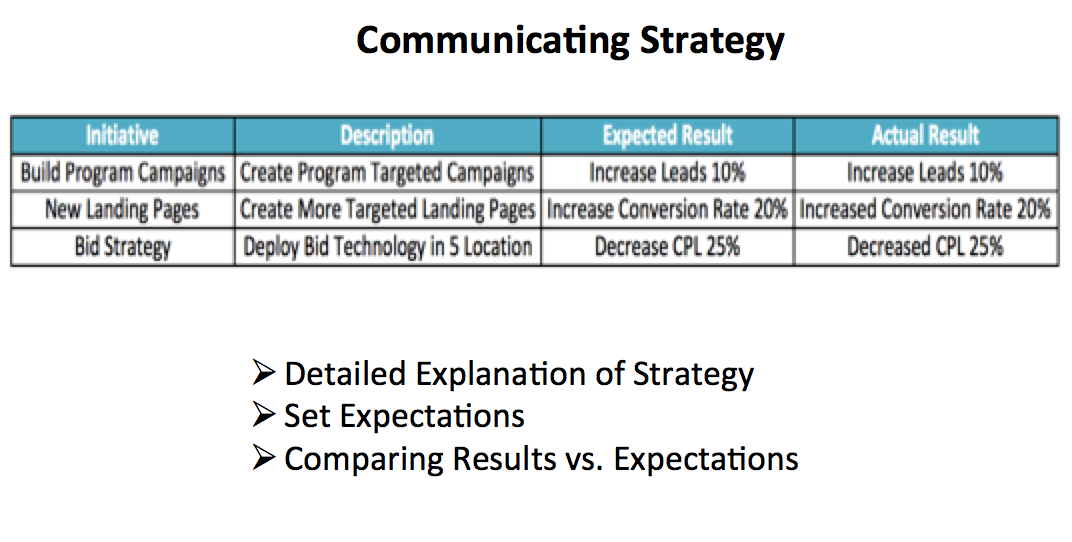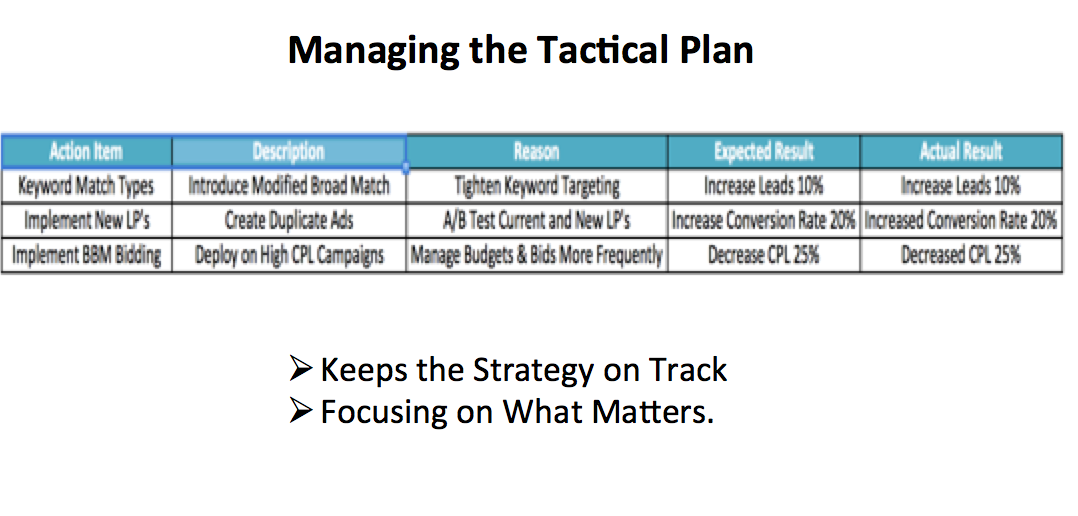I’ve spent quite a bit of time recently reflecting on how I’ve managed my accounts over the years. As I’ve gone through this process, I have discovered 12 things that lead to better performance and increased efficiency when done consistently. When I deviate from these 12 steps, performance tends to suffer and account (not to mention client relationships) get even more difficult to manage.
Below is my 12-step program for successful PPC account management.
Step 1- Clear client goals and objectives are needed.
Looking back at every PPC account I’ve managed, those accounts that had clear performance goals significantly outperformed those where goals were not clearly defined or constantly changed. Goals are critical in that they allow us to create strategies and employ tactics that are in line with business needs.
Step 2- Solid strategies and focused action plans lead to account success.
Once solid goals and objectives are set, the next step is figuring out how they will be achieved. I list every strategy & tactic in an Excel spreadsheet, a description of what the strategy or tactic is, and an expected result. Going through this exercise helps me stay focused only on the most important tasks. Once I list everything out and examine the expected result, I can decide whether or not a specific task will improve performance enough to warrant taking that initiative.
Step 3- Work only on tasks that significantly ‘move the needle’.
My nature is to accomplish everything perfectly, all the time. I have come to realize this is an unattainable standard. Working only on the most essential things has allowed me to work less total hours per account while significantly improving performance. This has opened up my capacity to uncover new areas of growth as opposed to being bogged down in mundane account tasks.
Step 4- Conduct routine account audits to uncover growth opportunities and areas of optimization.
Being as involved in our accounts as we are, it’s important to take a step back from time to time and examine the big picture. We need to honestly assess what’s working well, where we need to improve, and where the opportunities are.
Whenever I fail to go through this exercise, I find my account’s performance first stagnates, and then deteriorates. Always be on the lookout for areas of improvement and growth.
Step 5-Use automated tools, alerts, & scripts to work more efficiently.
My default approach to account management is old school. I think that comes from starting in this business prior to automation! However, in my effort to become more efficient and strategic, I needed to employ automation to be my extra set of eyes and hands in my accounts. For instance, I use automated bidding wherever possible, employ account alerts to notify of potential problems, and scripts to automate those routine tasks that take away time from important, growth focused work.
Step 6- Report and analyze every aspect of our paid search accounts all the time. Obsessively track every aspect of our campaigns.
We need to know everything about our accounts in order to reach goals. If we don’t understand the performance data our accounts are generating, we cannot make the changes nor employ the tactics necessary to take things to the next level. Google, Bing, & the other paid search platforms we use, provide unique insights into user behavior. Analyzing that data is absolutely key to keeping our paid search programs on track.
Step 7- Consistently examine and adjust account structures to ensure their ppc program is scalable and always poised for growth.
Account structure should mirror your client’s business model. We recently restructured a large account where the layout did not match business needs. Since the restructure, lead volume has grown significantly. Businesses and search marketing platforms constantly change, so make sure your account structure is keeping up with the times. A good account structure leads to efficiency and growth.
Step 8- Ignoring remarketing is a major lost opportunity.
On average, my accounts convert about 4%-5%. That means 95 out of 100 clicks don’t convert! This is where remarketing comes into play. Before remarketing, those prospects were lost forever. With remarketing, we have an opportunity to reengage users who were not ready to convert at the time the first time. Remarketing can turn a lost click into a recurring customer. Be sure to employ this tactic.
Step 9-Mobile advertising is here to stay and brings tremendous value to accounts.
We live in a mobile society and this opens an opportunity to touch these users in unique ways. Mobile advertising can drive high quality phone conversions and in-store sales, in addition to traditional web leads and sales. Advocate to your clients for mobile enabled landing pages and ensure mobile specific ads are in place that speak to this unique user base.
Step 10- Constantly test ad copy to increase CTR%, conversion rate, & overall qualified traffic.
I have never had an instance where CTR or conversion rate hasn’t increased over time when testing ad copy on a regular basis. It’s easy to do, but don’t treat ad copy as just another ‘to-do’. Think of ad copy as a strategic way to drive more qualified traffic to your sites. Having a structured plan for testing ads will lead to positive results and push your account forward.
Step 11- Routine landing page-testing increases conversion rates and makes our paid search efforts more profitable.
Whenever my clients actively test their landing pages, I see increases in conversion rate and overall volume. Consequently, when clients are not actively testing, performance erodes over time. Not much more to add here other than to test, test, test!
Step 12- Having achieved basic account success through Google, expand to Bing, Facebook, Twitter, & any other paid search platform that can bring us additional volume.
Google is the natural starting place for us to begin our paid search program. Because of the size and scope of the network, this is the best chance for us to get the most lead or sales volume. However, Bing, Facebook, Twitter, and LinkedIn provide a cost effective way of scaling our PPC programs. We will not get the same volume as Google but as these channels grow, the potential to increase business for our clients increases.
Hopefully you’ll apply these steps and see significant performance improvement. It’s worked for me!





